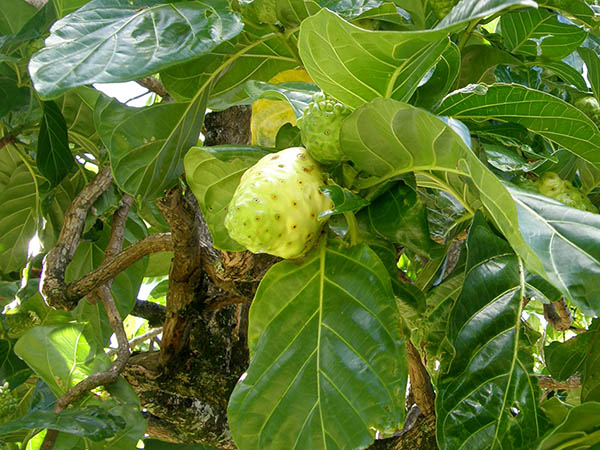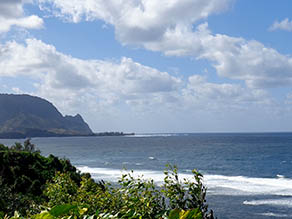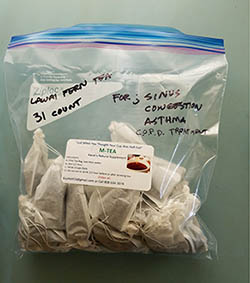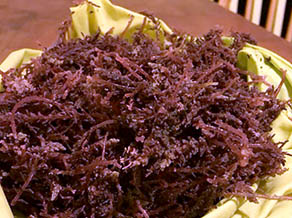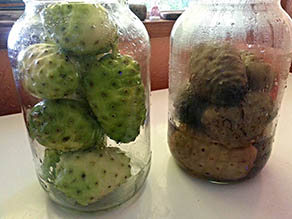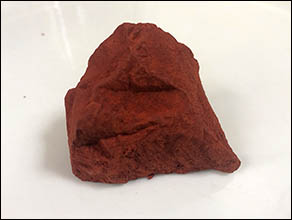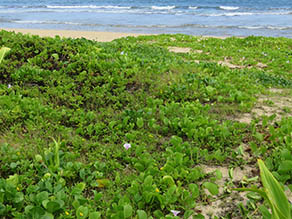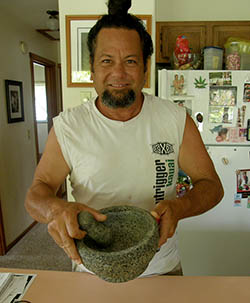 |
 |
 |
 |
||||||
|
|
|
|
|
|
|
|
|
|
 |
“If you ask me, every single plant in the forest has a medicinal use," Kawika says. "Somebody has put a list together and there has been more than recorded, roughly more than 2,000 Hawaiian names for plants. You look at how many plants that the botanists say we have, it’s about 2,000. So you hear people say that Hawaiians have a name for a plant only if they knew its use or had a use for it. That’s true, but we have a use for every plant, so every plant had a name. And then sometimes they say, ‘Oh, what is this for?’ Sometimes the use of a plant was just inspiration: it’s there growing on a cliff, it’s beautiful, I’m going to work that into my oli somehow because I’m inspired by its beauty. That’s a use. “We have relationships with everything—everything has names. I think Westerners don’t have a concept of how intensively named everything was in old Hawai‘i. From place names to plant names, to wind names, cloud names, rain names, everything had a name. It’s just how the kūpuna developed relationships with things. They gave it a name so they could communicate with it. And if you’re a culture that communicates with every little aspect of nature, everything is going to need a name.” In Hawaiian language, herbal medicine is called lā‘au lapa‘au, "plant medicine," but even the world lā‘au (plant, tree, etc) can mean "medicine." “Grandma Rachel also was like a healer, medicinal,” Lahela tells us. “I learned only a few from her, because I really at the time wasn’t absorbing it. It was like ‘Okay, we gotta go gather.’ My brother Pa‘ula was the one for gathering the more complicated stuff—plants. “We still do a few of the medicines. You know the trees whatever helps us more. Asthma or of the cold, broken bones, infections, diabetes, so the most plants are koali, kukui or ōhi‘a ‘ai which is the mountain apple, the tree bark. Of course the tī leaf helps draw the fever, we use that to pull out the fever from the body. Kukui is the nut—for the mouth, we use it for many ways, coughing, or sore throat, thrush for the baby, use that for clean the mouth and the tongue.” 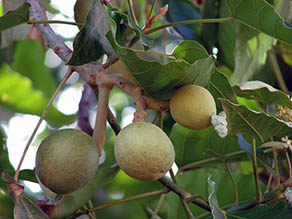
“I‘ve seen my grandmother going into the bushes,” Nalani recalls, “and pick up plants and utilize them. Honestly, we never really saw what they picked, or what they were going to use it for, until something would happen. If you got sick, they would already have it ready, so it’s not like they actually showed you how to make it. But it wasn’t about having to take you to a doctor. They were just using natural remedies that were picked. Unfortunately they didn’t really share it, although today we do have people that practice lā‘au lapa‘au. But for us they never revealed what the plant was or how they prepared it. “Some of it was rubbed on your tongue, like the sap from the kukui when you picked it off the tree. Say you don’t have an appetite and have this white coating on your tongue, they would dab on the sap of that kukui nut and rub it. It tasted horrible, it really does! But that would make you get your appetite back. They would say, ‘You got too much air’ or something, and it takes away your appetite. And so they would always clean your tongue with that. “If you had an infection in your mouth, you’d gargle with Hawaiian salt and water. It seems that Hawaiian salt is always an important part of remedies. They used to take the inner bark of the ‘ōhi‘a ‘ai tree—the mountain apple tree—and they used to bring it in and smash it with Hawaiian salt and then you would apply it if you had, say, a sprain. You would apply it to that, and bind it. Those are the things that I remember.” 
“The primary use of ‘ōhi‘a‘ai is lā‘au,” Kawika attests. “Whenever you talk to the kūpuna about mountain apple, the first thing that comes to mind is medicine, not food, because that’s how it was primarily used. I mean, it only fruits for like a month out of the year. You’re not going to plant agroforestry of that for a month’s worth of fruits. It takes up a lot of time and space, and it’s a very strong medicine, and a useful wood.” “We like to take a lot of the medicinal products from the base of the tree,” Guy explains, “because that’s where the tree is the strongest and it holds up the tree. So the strength is near the bottom of the base of the tree always. You can always find the strength of the medicinal purposes of the plant in the stems and in the bark near the base of the tree. "They have a pōpolo plant that they used to use for broken bones. And you take the bottom of the root and the bottom of the bark and you mash it all together with some Hawaiian salt and you do some pule and some prayers and you rub it in the skin and then you put some of that koali mix that I mentioned earlier, the koali and the Hawaiian salt mix, mash it together and you put it all around and you wrap it up with ti leaves and noni leaf and leave it on for like three days if you can—for 36 hours—and when you take it off, you are pretty much healed. And the swelling is gone, everything is gone, the pain is gone, it’s strong again. It’s crazy.” “If you have a sinus congestion, you want to use the laua‘e fern, and what you do is you get the oldest of the lawai‘a fern, you pull the whole root system out of the ground with the plant, cut the stem off, wash it down and then put it in a pot of water, make a tea out of it and drink the tea. Within five minutes your congestion and your sinuses and everything is clear. This is the native lawai‘a fern. It’s always in the mountains and in the heiau. You can find them all by the sacred grounds. Because that’s where they always were. That’s why I don’t have to gather so much, it’s everywhere. You just got to know what illness somebody has and I just know certain areas around the island where I can find, this, this, this, this.” Guy talks about treating cancer. “Before I gather, I usually start off with a simple prayer every day. It’s basically starting off with the Lord’s Prayer, but in Hawaiian: ‘Our Father who art in heaven, hallowed be thy name. Open the doors for the children for they are our future. Forever descending from the heavens and back again, Amen’.” “The blessing that I got is that I can identify the plant just from the words that my Grandma taught me and that she showed me. She drew pictures, hand drawing, and then I could tell what I’m looking for now, and just see those little drawings. Yeah, just learning that stuff at an early age and it just stayed in my brain and it’s stuck in there and now I can just identify it just by walking around. In the forest or on the side of the road, pretty much anywhere, on the beach, it’s everywhere. Life, and good life in living, is all around us. “Say I’m looking for the seaweed for the medicinal purposes for the women. I’ll ask in the light as I’m standing by the shoreline, ‘Which angle do I go, which way do I go?’ and almost automatically the spirit can just guide me and I can just go right to where it’s the promised land. Honestly, I don’t have to stay there long—ten or fifteen minutes and I’m done. And other people will go look for the stuff for hours and they can’t even find it. But it’s knowing what you’re looking for also.” “There’s a lot of the medicinal seaweed that helps women, especially when they are going through their ma‘i or through their menstrual period. They lose a lot of blood so they lose a lot of iron and iodine. And there is a particular seaweed called limu kohu that grows all over this island, you’ve just got to know what it looks like. And it helps the women replenish their blood and their iodine and gives them back their energy so they don’t feel so sluggish anymore, and it picks them back up and so everything is good again—pono. “Noni is a cleansing agent. I was taught by my grandmother when we were young. She would ferment a couple of the fruit in a big glass jar and we’d have to drink that fermentation at the bottom. A big tablespoon every day. What it does is it cleans the body, cleans your pancreas, your liver, your kidneys, everything in your body, so then you’ll be closer to god, and cleanliness was always godliness. So that’s how we have this connection with God because we’re always clean from the inside out—not just the outside in, but the inside out also. “We also make our own salt here, out of the clay beds on the west-south-west side of the island. But also after we are done making the salt, we add alae to it. There are two different types of ‘alae dirt. One is really dark, dark red and it's a female dirt and it is good for human males that have bad blood diseases. And then the male dirt has white streaks in it, and now that’s good for female humans. And it’s been put through the laboratories, the United States, and they checked it and they said yes, it is medicinal, it is part of the lā‘au lapa‘au of the Hawaiian culture, and then that’s why we never had any bad blood diseases, because we knew how to cure it right away.” “This is Kaua‘i salt, Kaua‘i ‘alaea,” Leilani offers. “Every island has its own ‘alaea. Kaua‘i is very rich I believe. I was taught it’s female, which is good for male and men, the opposite kind of thing. But this is very old from north shore side. It was passed on to me by my husband and so I use it in the salt to help with the immune system, to build a stronger immune system. And you can mix it with Hawaiian chili pepper, salt, not just as a seasoning but it helps with ailments like a congestive heart. It helps to work on that, and just a whole array of things. “The salt is granulated. I usually keep a batch from the salt ponds in Hanapepe. It’s not something you can buy at the store. I just freshly mixed this. What you need to do is set the salt in the sun and let the sun blend it and it will melt some. When we put it out in the sun, its just a melting, blending process. I like for the sun's energy to do that. And then when its done just break it up and keep it for whenever you want. Seasoning on your foods, or if you want to keep it for any special medicinals. If you get all bust up inside, this is good to dowse in an eight-ounce glass of piping-hot water so that it will help heal any of the wounds. In an eight-ounce glass, put a tablespoon and drink it down as hot as can.” Learn about salt-making on Kaua‘i. Lā‘au lapa‘au can also involve externally applied treatments. “My Mom was cracker-jack: when I had anything wrong, okay, treat ‘em.” Samson remarks. “One day I came home, oh the car banged the cab, and when I come home from work, I’d take care. For me it was just, you got to go doctor and get sting. My mom was home here. I came over and she said ‘Oh, good morning son.’ Then I tell her, I was laughing already because she can fix that up. So I tell her. ‘No, problem I go fix that up.’ So anyway I saw her, let her do that. Usually you buy the medicine, three days application. Like figure, well, we just apply that thing. Took the regular morning glory—plenty—that thing grow all over. But there’s another one: green stem, kinda rough, football-shaped leaf—a dark green plant. It's not the morning glory, that’s another one—we use them too—but the morning glory has—you get more moisture than you can get. And that morning glory grow all over. “You just pulverize them—you know, pound away and smash them up, the juice come out. You just pound away, you get the juice and then always put salt. You can see that getting good enough, just mix them up. Just apply them overnight. Most anytime we used them, put them on three days. The last incident that we did for people was my friend’s boy was playing high school, bang ‘em. You know what is Charlie Horse, yeah? When the guys want to touch, he goes ‘Ooooooh!’ They trying to hold him back. “So I told him ‘How bad?’ Oh, didn’t want for touch them. That’s bad enough, so I said ‘Come down, I’ll wait for you near Powerhouse Road.’ Plenty on the side right there, but it’s steep on the side of highway, too dangerous. So I told him about that, but it’s not safe because now it’s going too dark on us after work, in the night already. The safest place is down here. Just so you know. Anyone play football, you get banged. I told him ‘Eh, you not supposed to get banged.’ It’s just a game. Run away. They learn.” Nalani remembers a very special medicinal treatment: “The turtle has a green fat, the fat is green. My grandfather, when we would fry it, he would save the the oil from that fat and use it as medicine. When I was nine years old I was burning a pile of rubbish and didn’t realize my sister wrapped up a can of vegetable soup in the newspaper. She put it in the newspaper because it was outdated, but I didn’t know that. “Back then we could burn our own rubbish in the back yard, so there I was kneeling down, burning the rubbish, and it exploded, and it burned my whole face from under my neck to my forehead. It was gnarly, I looked like a monster. My grandfather utilized that oil from the turtle fat, and applied it. It stank like hell, but they kept my face always rubbed down with that oil. I don’t know for how long, but I know I didn’t go to school for two months. I would be scarred for life, but fortunately by utilizing that, you’d never know I was burned.” “I think some people approach lā‘au lapa‘au with a really western approach,” Kawika warns. “They say, ‘I just want to know what this plant is good for.’ It’s not like a formula: when you have this sickness, you take this plant in this proportion. That’s totally not the way that healers approach things. Sometimes it’s not going to be the same plant every time. It’s going to be different proportions and different mixtures of plants for that particular purpose. But it’s not just something you look up in a book and say ‘Okay, this is the illness, this is the plant, five leaves, two cupfuls of this, okay you’re done.’ That is the most wrong way to approach healing, in the Hawaiian context.” “It’s not something that’s just ‘Take these two pills, and say these three lines and you’ll be good to go,’ Leilani agrees. “That could work, if the divine connection is strong.” "One of my kumu hula taught me, if you’re not pono within yourself, you can never heal anybody,” Kawika says, “because you’re not going to be connected to the spirit in such a way that you’re open and ready to receive and facilitate healing. You have to be pono with yourself to be able to connect to the spirit, and the spirit will tell you what is required to cure this, to address this problem. And that involves lifestyle changes in conjunction with particular plants.” See Plants in Hawaiian Medicine By Beatrice H. Krauss, Martha Noyes, pp. 50-54.
|
 |
|||||||

|
|
||||
| Copyright 2018 Pacific Worlds & Associates • Usage Policy • Webmaster |
||||
